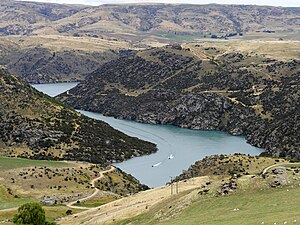Lake Roxburgh
| Lake Roxburgh | |||||||||
|---|---|---|---|---|---|---|---|---|---|
| Lake Roxburgh | |||||||||
|
|||||||||
|
|
|||||||||
| Coordinates | 45 ° 47 ′ 0 ″ S , 169 ° 32 ′ 0 ″ E | ||||||||
| Data on the structure | |||||||||
| Lock type: | Gravity dam | ||||||||
| Height of the barrier structure : | 48 m | ||||||||
| Crown length: | 358 m | ||||||||
| Power plant output: | 320 MW | ||||||||
| Operator: | Contact Energy | ||||||||
| Data on the reservoir | |||||||||
| Water surface | 5.9 km² | ||||||||
| Reservoir length | 28.5 km | ||||||||
| Reservoir width | 667 m | ||||||||
| Total storage space : | 107 000 000 m³ | ||||||||
|
Part of the reservoir, 3 km above the dam (view to the southeast) |
|||||||||
| Dam with power station and part of the reservoir | |||||||||
The Lake Roxburgh is a reservoir in the region Otago on the South Island of New Zealand . It was created by damming the Clutha River near the parish of Roxburgh .
geography
The Lake Roxburgh extends 15 km south of Alexandra over a length of 28.5 km of the in the former riverbed Clutha River . Dunedin , the capital of Otago, is a good 100 km southeast of the lake.
operator
The operator of the power plant and responsible for the Roxburgh Dam and the reservoir is Contact Energy , the second largest electricity producer in New Zealand after Meridian Energy .
Technical specifications
When it was commissioned, the reservoir had a length of 28.5 km and a maximum width of 667 m, was up to 42.7 m deep and had a capacity of around 107 million m 3 . The regular water level of the lake was 132 m above sea level, with the water flow between 225,000 l / s., On average 340,000 l / s. and at peak times up to 722,000 l / s. amounted to. This meant that the water in the lake could have exchanged in 1.7 to 5.5 days. In normal operation, the water level of the lake fluctuates by up to 1.8 m depending on the use. Since 2009 the water level of the lake has increased by 60 cm, so that today we have to assume slightly different data.
The lake's hydropower plant has eight turbines with a nominal output of 320 MW of electricity.
history
The construction of the reservoir for electricity generation was the largest construction project that New Zealand had completed up to that point in time and the power plant with 320 MW output was the second largest at the time of commissioning. Construction of the dam began in 1949, but it was not until 1956 that the reservoir was ready for use with the completion of Roxburgh Dam . Commissioning up to maximum output and capacity took another five years until 1961. In 2009 the Contact Energy company successfully applied for the lake level to be raised by 60 cm.
Consequences of the dam project
But the disadvantages of the dam project soon became apparent. Due to sedimentation, the reservoir flattened noticeably, so that floods due to extreme rainfall in the city of Alexandra, a few kilometers above the lake, increased in frequency and intensity. In the years 1994 in January, 1995 in December and 1999 in November Alexandra was surprised by three large floods with increasing water levels. In 2001 it was assumed that Lake Roxburgh had already lost 44% of its original storage capacity due to the deposits and this is assumed to be the cause of the more extreme flooding above the lake. Flood protection walls up to 143.25 m above sea level in the city and lowering the lake level should similarly prevent disasters in the future. As an example, on April 27, 2010, as a result of heavy rainfall, the water level of the lake was lowered by up to 6 m in order to be able to absorb the following floods.
Web links
- Building the Roxburgh dam . Te Ara - the Encyclopedia of New Zealand, July 3, 2013,accessed June 9, 2014(1951National Film Unit filmentitled "Power Progress").
Individual evidence
- ^ JW Winter : A Survey of Lake Roxburgh. A recent Hydro-Electric Dam . (PDF 1.7 MB) New Zealand Ecological Society, 1962, archived from the original on July 15, 2014 ; accessed on January 14, 2016 (English, original website no longer available).
- ↑ a b Contact Hydro . (PDF 1.8 MB) Contact Energy , archived from the original on July 14, 2014 ; accessed on June 9, 2014 (English, original website no longer available).
- ^ A b Roger Young, Graeme Smart and Jon Harding : Impacts of hydro-dams, irrigation schemes and river control works . In: NZ Hydrological Society, NZ Limnological Society (Ed.): Freshwaters of New Zealand . Christchurch 2004, ISBN 0-476-00708-9 , Chapter 37 , pp. 37.1–37.15 ( Online (PDF 1.5 MB)).
- ^ Hydro - Lake Level Rise . Contact Energy , archived from the original on July 14, 2014 ; accessed on June 9, 2014 (English, original website no longer available).
- ↑ a b Overview Effects of the Clutha Hydro Schemes on the Environment . Alexandra District Flood Action Society , August 11, 2001, accessed June 9, 2014 .
- ↑ John Edens : Lake Roxburgh dropped by 6m . The Southland Times , April 28, 2010, accessed June 9, 2014 .



